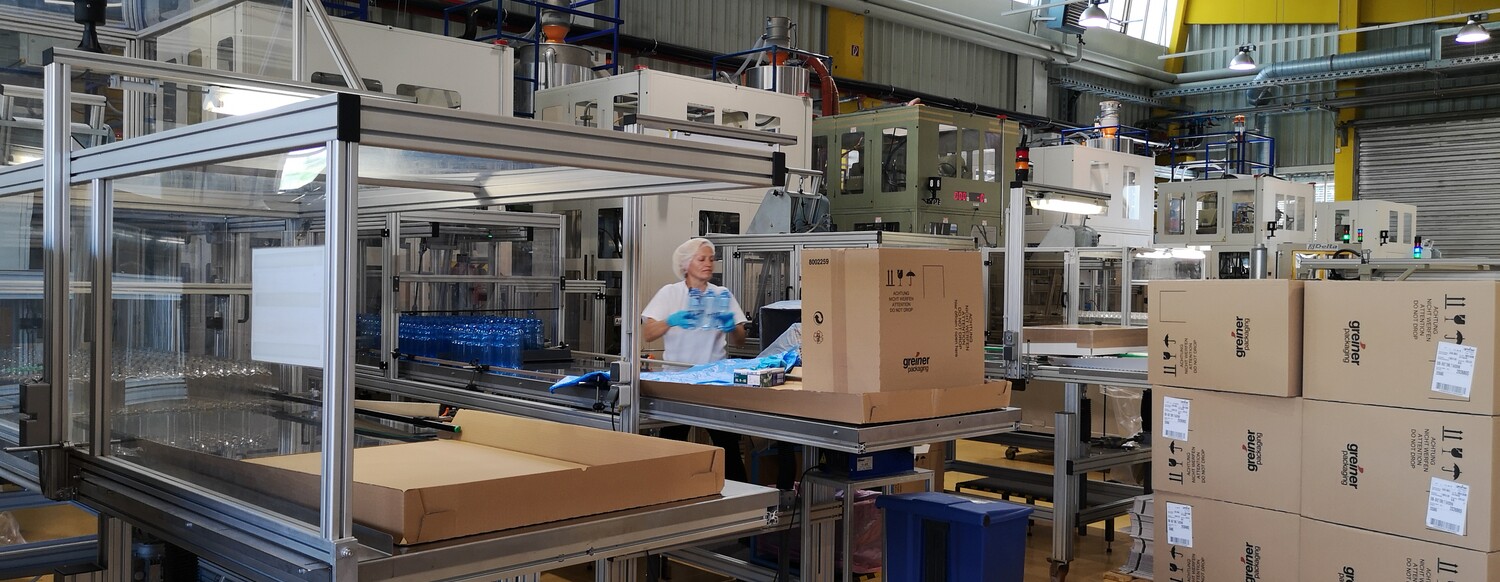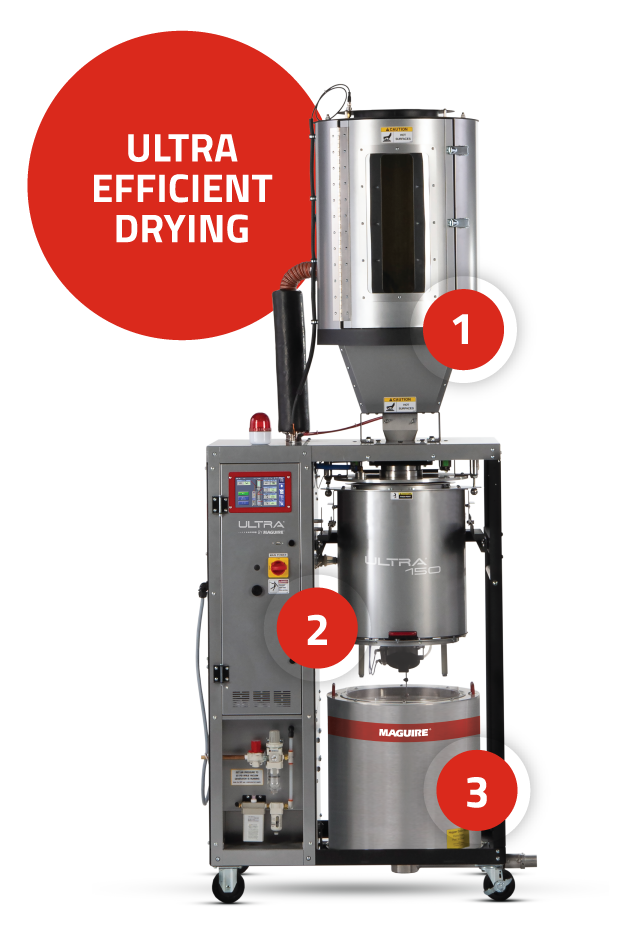Packaging manufacturer invests in sustainable products and resource-efficient production.
A major packaging manufacturer of food and non-food packaging is pursuing a holistic sustainability strategy. This includes reusable products with a high percentage of rPET as well as an energy-efficient and resource-preserving production process that results in lower CO2 emissions. For the drying of PET in injection stretch blow moulding, the company is currently testing a new vacuum dryer as a replacement for conventional desiccant dryers. The results are promising: The new devices use less energy and – in addition to many other benefits – allows quicker material changes.
Greiner Packaging is an internationally operating developer and manufacturer of innovative plastic packaging.The company is widely viewed as Europe’s leading provider of dairy packaging. In addition, Greiner Packaging offers custom solutions for plastic bottles and containers that are used both in the food and non-food sectors. At its plant in Kremsmünster, Austria, the head office of Greiner, the company produces ready-to-use packaging by employing different processes, including injection stretch blow moulding, thermoforming and sheet extrusion. Furthermore, the company offers decoration processes, such as IML, printing, labelling or the technology for cardboard-plastic combinations that Greiner developed in-house.
Greiner’s production plant in Wartberg focuses on the production of large sized 5-gallon water bottles, containers, and tubes using a single-stage injection stretch blow moulding process. At first a preform is moulded with a mouth piece that has already been fully formed. As a second step the preform is pre-stretched (blow mould) using the remaining residual heat and subsequently blow-moulded into to the final product.
The plant runs 24 hours a day, 7 days a week in four shifts. Sustainability is the order of the day Greiner Packaging has set ambitious sustainability objectives: By 2025, the company wants to launch fully recyclable, reusable or compostable plastic packaging only. Furthermore, Greiner is aiming to reduce plastic waste significantly and increase the percentage of rPET of their products. The company has recently extended its participation in the New Plastics Economy Initiative. Greiner Packaging joined the initiative back in 2016, as one of the first packaging companies worldwide.
The main objective is "to save as much plastic materials as possible and thereby eliminate waste,“ says Karoline Mossbauer, head of communications at Greiner Packaging, "and to reuse the remaining post-consumer waste in a manner that is as sustainable as possible“. The biggest challenge is to find the right materials and to implement suitable material flows, which is a difficult task – especially in the area of food packaging, which constitutes a big part of Greiner’s production.
The European Food Safety Agency (EFSA) mandates that 95 percent of the recycling material has to come from a main flow that had verifiably already been used for good packaging. Only rPET has been approved as the sole recycling material for food packaging. Greiner Packaging is involved in multiple projects concerning the use of rPet in the food sector. rPet, as well as rPO, which Greiner is currently mainly using in pallets and is testing for other applications, is already being used for non-food products. A shampoo bottle made from rHDPE that the company is producing has already been launched.
At Greiner, the notion of sustainability not only encompasses products but rather all of the company’s activities. Resource preservation is an important issue. For example, the Greiner Group, which, in addition to packaging, is also active in the extrusion technology, medical technology/diagnostics and foamed materials sectors, has pledged to reduce its specific overall energy consumption by 10 percent by 2025 and by 20 percent by 2030. Using environmentally friendly production processes, CO2 emissions are to be reduced by 38 percent (2025) and 53 percent (2030) respectively.
Successful Test of ULTRA Dryer
An energy-efficient and reliable production is also high on the agenda in Wartberg. An important step in the injection stretch blow moulding process is the drying of materials because residual moisture prevents reliable processes, which results in inconsistent variations in quality.
In the past, Greiner Packaging at Wartberg used conventional desiccant dryers to dry raw materials which has become a challenge. "Our core competence is the development and production of customer-specific products“, explains plant manager Stefan Bürtlmair, "whereas our product portfolio also includes standard products“.
As part of a continuous improvement process, many material tests are required. Long drying times when using conventional drying technology often slow down the process.
That is why, at K 2016, the production experts of Greiner Packaging were looking for an alternative – and found it in the form of the ULTRA-series vacuum dryers from Maguire. "We tested the new vacuum dryers for a year and it was a positive experience“, says Dietmar Aigner, head of technology. Speed is one way in which their advantages are reflected. "A material change takes an average of 40 minutes compared to about three hours with conventional desiccant dryers“.
This means that the injection stretch blow moulding experts in Wartberg can test between six and eight materials each day while, in the past, they could only do two. So far, Greiner has used the vacuum dryers in test series with PET and the copolyester Tritan (brand name).
Drying Without Desiccant
There is a major difference between vacuum drying technology and a conventional desiccant dryer.
Conventional drying methods re-circulate hot air for hours to remove moisture from the pellet.The saturated air is then being dehumidified using a molecular sieve (a hygroscopic drying desiccant) before being circulated as dry air back into the process.
Since the desiccant needs to be regenerated on a regular basis, modern desiccant dryers require two or more molecular sieve cartridges which are interchangeable.
A vacuum dryer, however, does not require a desiccant. The technology takes advantage of the simple physical principle of the boiling point of water decreasing when the air pressure is reduced. In a vacuum of 90 percent, the boiling point of 100 °C is reduced to 56 °C as a result of atmospheric pressure. When the pre-heated material is moved to a vacuum, the moisture evaporates from the material quickly and is released into the surrounding vacuum atmosphere. The ULTRA low energy dryer from Maguire operates in a three-step drying process:
- Using a heating unit, a centrifugal fan brings the material to an adjustable target temperature in a heating hopper. That value refers to the temperature at which the material is optimally pre-dried and it varies by the type of plastic. The target temperature for PET is 170 °C. The initial heating process for various materials is about 40 minutes and it takes approximately 60 minutes for PET.
- Once the target value has been reached, the material is moved to the vacuum chamber. The amount of material is monitored by a pair of load cells to know the amount of material and adjust if required. In the vacuum chamber, the air pressure is brought to 700 mmHg (90 percent vacuum) and maintained for a specified period of time. The material remains in the vacuum chamber for 20 to 30 minutes depending on the material type, initial moisture and required throughput.
- In step three of the process the vacuum-dried material is moved to a material retention hopper, which is also monitored by load cells. The load cells monitor usage and signal when to feed from the vacuum hopper. The membrane dry air purge option provides a supply of -40 °F/-40 ° C dew point air to purge the vacuum chamber and blanket the retention hopper. Using a slightly positive air pressure, the dried material is kept in a stable, dry environment.
According to information provided by Maguire, the vacuum dryer dries the granulate six times faster on average than a conventional desiccant dryer. Replacing molecular sieve dehumidification with a vacuum process is the reason for the striking amount of time saved.
Author: Ralf Mayeris the editor-in-chief of Plastverarbeiter [email protected]



